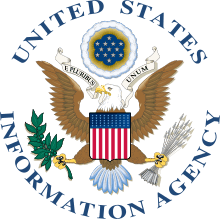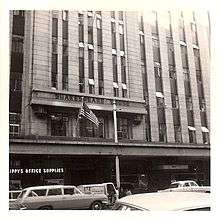United States Information Agency
 Seal of the U.S. Information Agency | |
|
Logo of the U.S. Information Agency | |
| Agency overview | |
|---|---|
| Formed | August, 1953 |
| Dissolved | October 1, 1999 |
| Superseding agency | |
| Jurisdiction | Federal government of the United States |
| Headquarters | Washington, D.C. |
The United States Information Agency (USIA), which existed from 1953 to 1999, was a United States agency devoted to "public diplomacy". In 1999, USIA's broadcasting functions were moved to the newly created Broadcasting Board of Governors, and its exchange and non-broadcasting information functions were given to the newly created Under Secretary of State for Public Diplomacy and Public Affairs at the U.S. Department of State. The agency was previously known overseas as the United States Information Service (USIS).
Mission
President Dwight D. Eisenhower established the United States Information Agency in 1953.[1][2] The USIA's mission was "to understand, inform and influence foreign publics in promotion of the national interest, and to broaden the dialogue between Americans and U.S. institutions, and their counterparts abroad".[3] The United States Information Agency (USIA) was established "to streamline the U.S. government's overseas information programs, and make them more effective".[3] The United States Information Agency was the largest full-service public relations organization in the world, spending over $2 billion per year to highlight America's view, while diminishing the Soviet's side through about 150 different countries.[1]
Its stated goals were:
- To explain and advocate U.S. policies in terms that are credible and meaningful in foreign cultures;
- To provide information about the official policies of the United States, and about the people, values and institutions which influence those policies;
- To bring the benefits of international engagement to American citizens and institutions by helping them build strong long-term relationships with their counterparts overseas;
- To advise the President and U.S. government policy-makers on the ways in which foreign attitudes will have a direct bearing on the effectiveness of U.S. policies.[3]
Propaganda played a large role in how the United States was viewed by the world during the Cold War. American propagandists felt as though the Hollywood movie industry was destroying the image of the United States in other countries.[4] In response to the negative portrayal of the U.S. from communist propaganda the "USIA exist[ed] as much to provide a view of the world to the United States as it [did] to give the world a view of America".[5] The purpose of the USIA within the United States was to assure Americans that, "[t]he United States was working for a better world".[6] Abroad, the USIA aimed to preserve a positive image of the U.S. regardless of negative depictions from communist propaganda. One notable example was Project Pedro, a secretly funded project to create newsreels in Mexico during the 1950s that portrayed Communism unfavorably and the United States positively.[7] Journalistic articles reflecting the views promoted by the USIA were frequently published under fictitious bylines, such as "Guy Sims Fitch".[8][9]
In order to accomplish the advisory portion of its mission, the agency conducted research on foreign public opinion about the United States and its policies, in order to inform the president and other key policymakers.[10] The agency did this through public opinion surveys throughout the world. It then issued a variety of reports to government officials, including a twice-daily report on foreign media commentary around the world.[10]
Media and divisions

From the beginning, Dwight Eisenhower said, “audiences would be more receptive to the American message if they were kept from identifying it as propaganda. Avowedly propagandistic materials from the United States might convince few, but the same viewpoints presented by the seemingly independent voices would be more persuasive”.[6] According to the Kennedy memorandum, the USIA utilized various forms of media, including "personal contact, radio broadcasting, libraries, book publication and distribution, press motion pictures, television, exhibits, English-language instruction, and others”. Through these different forms, the United States government was able to distribute and disguise the propaganda more easily and engage a greater concentration of people.[5]
Four main divisions existed at the beginning of the USIA's propaganda effort.[4] The first division dealt with broadcasting information both in the United States and around the world. One of the most widely used forms of media at the onset of the Cold War was the radio. The Smith-Mundt Act authorized information programs, including Voice of America.[11] Voice of America was intended as an unbiased and balanced "Voice from America" as originally broadcast during World War II. The VOA was used to "tell America's stories...to information deprived listeners behind the Iron Curtain”.[1] By 1967, the VOA was broadcasting in 38 languages to up to 26 million listeners.[5] In 1976 VOA gained its so-called "Charter" which required its news to be balanced.
The second division of the USIA consisted of libraries and exhibits. The Smith-Mundt Act and the Fulbright-Hays Act of 1961 both authorized the international cultural and educational exchanges (the Fulbright Scholarship Program). Thus "Fulbrighters" were grant recipients under the USIA educational and cultural exchange program. To ensure that those grant programs would be fair and unbiased, there were a series of grantees of educational and cultural expertise who chose the actual grantee recipients.
The USIA's third division included press services. Within its first two decades the "USIA publishe[d] sixty-six magazines, newspapers, and other periodicals, totaling almost 30 million copies annually, in twenty-eight languages”.[5] The fourth division dealt with the motion picture service. After the USIA's failed attempts to collaborate with Hollywood filmmakers to portray America in a positive light, the agency began producing their own documentaries.[1]
Non-broadcast educational and information efforts
By the time of the agency's reorganization in 1999, the educational and informational efforts encompassed a wide range of activities, outside of broadcasting, focused in four areas:
The agency produced electronic and printed materials, most notably a product known as The Washington File information service, intended to provide, in the words of the agency "both time-sensitive and in-depth information in five languages", incorporation full transcripts of speeches, Congressional testimony, articles by Administration officials, and materials providing analysis of key issues. The Agency has also running a number of web sites to transmit information.[10]
Second, the agency ran a "Speakers and Specialists Program", sending Americans abroad for various public speaking and technical assistance roles.[10] These speakers were referred to as "American Participants" or "AmParts".
Third, the agency ran over 100 "Information Resource Centers" abroad, including some public-access libraries in developing countries.[10]
Finally, the USIA-operated foreign press centers in Washington, New York, and Los Angeles to "assist resident and visiting foreign journalists", while also working in cooperation with other international press centers in other major cities, such as Chicago, Houston, Atlanta, Miami, and Seattle.[10]
Additionally, beginning with the 1958 Brussels World Fair, the USIA was responsible for the design, construction, and operation of the U.S. pavilions representing America at major world Expos.[12]
Abolition and restructuring
The Foreign Affairs Reform and Restructuring Act of 1998, Division G of the Omnibus Consolidated and Emergency Supplemental Appropriations Act, 1999, Pub.L. 105–277, 112 Stat. 2681-761, enacted October 21, 1998, abolished the U.S. Information Agency effective October 1, 1999, when its information (but not broadcasting) and exchange functions were folded into the Department of State under the newly-created Under Secretary of State for Public Diplomacy and Public Affairs.
At the time of its abolition, its budget was $1.109 billion. After reductions of staff in 1997, the agency had 6,352 employees, of which almost half were civil service employees in the United States (2,521). About 1,800 of these employees worked in international broadcasting, while approximately 1,100 focused on the agency's educational and informational programs, such as the Fulbright program.[10] Foreign service officers were also a significant portion of the work force (about 1,000).
Broadcasting functions, including Voice of America, Radio and TV Marti as well as other U.S. government-supported broadcasting, such as Radio Free Europe (in Eastern Europe), Radio Free Asia and Radio Liberty (in the former Soviet Union), were consolidated as an independent entity under the Broadcasting Board of Governors (BBG), which continues independently (as a separate entity from the State Department) today.
See also
- WORLDNET Television and Film Service
- Committee on Public Information
- Crusade for Freedom
- Cultural diplomacy
- Nine from Little Rock, an Academy Award-winning documentary by Charles Guggenheim, commissioned by the USIA[13]
- U.S. Department of State's Bureau of International Information Programs
- Foreign Broadcast Information Service
- Arthur Kimball, initial, acting, director of the agency
References
- 1 2 3 4 Snyder, Alvin, Warriors of Disinformation: American Propaganda, Soviet Lies, and the Winning of the Cold War 1995. Arcade Publishing, Inc. New York.
- ↑ Reorganization Plan No. 8 of 1953, 67 Stat. 642
- 1 2 3 "USIA: an overview". USIA. August 1998. Retrieved November 24, 2008.
- 1 2 Lefever, Ernest. Ethics and United States Foreign Policy (Cleveland, OH: The World Publishing Company, 1957).
- 1 2 3 4 Elder, Robert, The Information Machine: The United States Information Agency and American Foreign Policy (Syracuse, NY: Syracuse University Press, 1968).
- 1 2 Osgood, Kenneth. Total Cold War: Eisenhower's Secret Propaganda Battle at Home and Abroad. 2006. University Press of Kansas. Lawrence, KS.
- ↑ Fein, Seth, "New Empire into Old: Making Mexican Newsreels the Cold War Way", Diplomatic History 28 (2004): 703-748.
- ↑ Novak, Matt (27 September 2016). "Meet Guy Sims Fitch, a Fake Writer Invented by the US Government". Gizmodo. Retrieved 27 September 2016.
- ↑ Wilson P., Jr, Dizard (2004). Inventing public diplomacy : the story of the U.S. Information Agency. London: Lynne Rienner Publishers. p. 159. ISBN 9781588262882. Retrieved 27 September 2016.
These commentaries were prepared by a group of USIA editors (...) A long-running commentary on economic developments was attributed for many years to a fictional Guy Sims Fitch, whose views were often cited authoritatively in overseas publications
- 1 2 3 4 5 6 7 "USIA Factsheet". USIA Factsheet. USIA. Retrieved April 18, 2011.
- ↑ Friedman, Norman, The Fifty-Year War: Conflict and Strategy in the Cold War (Annapolis, MD: Naval Institute Press, 2000).
- ↑ The United States Information Agency: A Commemoration (PDF). USIA. 1999. p. 38.
- ↑ "The Charles Guggenheim Collection". Academy of Motion Picture Arts and Sciences. Retrieved April 10, 2012.
Further reading
- Bardos, Arthur, "'Public Diplomacy': An Old Art, a New Profession", Virginia Quarterly Review, Summer 2001
- Bogart, Leo, Premises For Propaganda: The United States Information Agency's Operating Assumptions in the Cold War, ISBN 0-02-904390-5
- Cull, Nicholas J. "The Cold War and the United States Information Agency: American Propaganda and Public Diplomacy, 1945–1989", ISBN 978-0-521-81997-8
- Gerits, Frank, “Taking Off the Soft Power Lens: The United States Information Service in Cold War Belgium, 1950–1958,” Journal of Belgian History 42 (Dec. 2012), 10–49.
- Snow, Nancy, Propaganda, Inc.: Selling America's Culture to the World, ISBN 1-888363-74-6
- Kiehl, William P. (ed.) "America's Dialogue with the World", ISBN 0-9764391-1-5
- Sorensen, Thomas C. "Word War: The Story of American Propaganda" (1968) ISBN 3-530-82750-9 ISBN 978-3-530-82750-7
- Tobia, Simona "Advertising America. The United States Information Service in Italy (1945–1956)", LED Edizioni Universitarie, ISBN 978-88-7916-400-9
- United States Information Agency, Commemoration Booklet Public Diplomacy: Looking Forward, Looking Back, Commemorative volume, 1999
- Yoshida, Yukihiko, Jane Barlow and Witaly Osins, ballet teachers who worked in postwar Japan, and their students, Pan-Asian Journal of Sports & Physical Education, Vol.3(Sep), 2012.
External links
| Wikimedia Commons has media related to United States Information Agency. |
- Records of the United States Information Agency (USIA) in the National Archives
- Archive of agency Web site
- Papers of Abbott Washburn (Special Assistant to the Director of the USIA, 1953 & Deputy Directior of the USIA, 1953–1961), Dwight D. Eisenhower Presidential Library
- The short film Answering Soviet Propaganda (1964) is available for free download at the Internet Archive